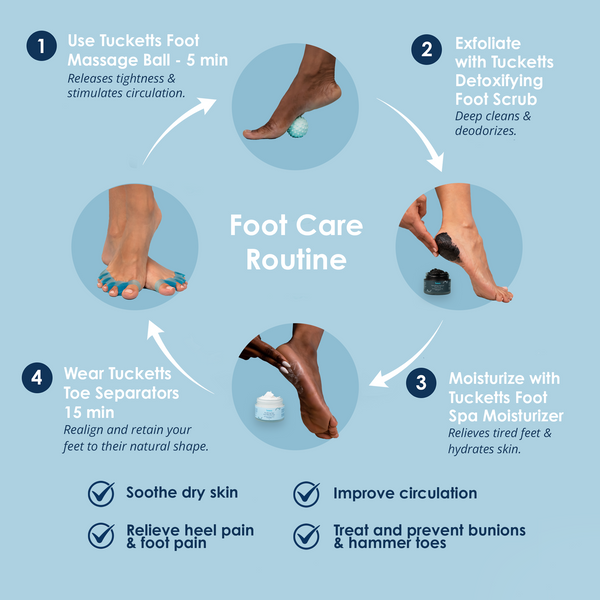To take care of your feet naturally, regularly wash them with mild soap and warm water. Avoid soaking your feet for long periods as it can strip the natural oils.
Having healthy feet is important for overall well-being and mobility. Whether you're on your feet all day or just enjoy being active, taking care of your feet is essential. Neglecting foot care can lead to various issues like dryness, cracks, calluses, and even infections.
Fortunately, you can maintain the health of your feet naturally. By following some simple steps, you can keep your feet moisturized, prevent dryness and cracks, and rejuvenate tired feet. In this guide, we will explore different natural ways to take care of your feet and keep them in tip-top shape without the use of chemicals or expensive treatments. So let's get started and give your feet the attention they deserve!
1. Proper Hygiene
Your feet work hard every day, carrying you from one place to another. Therefore, it's essential to prioritize their care and keep them healthy. One of the most crucial aspects of foot care is maintaining proper hygiene. By following simple and natural practices, you can prevent many common foot problems and ensure your feet stay healthy and happy.
1.1 Regular Cleaning
Regularly cleaning your feet is a fundamental step in maintaining foot hygiene. Start by washing your feet with warm water and mild soap, ensuring that you give equal attention to all areas, including between the toes and the soles. Cleaning your feet will not only remove dirt and bacteria but also help eliminate odors and prevent infections.
Here are a few tips to keep in mind while cleaning your feet:
- Use a gentle scrub brush or loofah to exfoliate dead skin cells and improve blood circulation.
- Ensure that you dry your feet thoroughly after washing them to prevent the growth of fungi and bacteria.
- Trim your toenails straight across to prevent ingrown nails.
1.2 Drying Feet Thoroughly
Aside from regular cleaning, drying your feet properly is paramount to maintain good foot hygiene. Excess moisture can lead to fungal infections, such as athlete's foot, or the development of painful blisters. To ensure your feet are completely dry, use a clean towel to pat them gently, paying attention to the spaces between each toe.
Follow these tips to ensure thorough drying of your feet:
- Avoid rubbing your feet vigorously with the towel, as this can cause irritation.
- After drying, it's advisable to wait a few minutes before putting on socks and shoes to allow any remaining moisture to evaporate.
- Choose breathable footwear and moisture-wicking socks to help keep your feet dry throughout the day.
By practicing regular cleaning and thorough drying, you can effectively maintain proper foot hygiene and reduce the risk of foot-related issues. Make these simple steps a part of your daily foot care routine, and your feet will thank you!

Credit: solelyoriginal.com
2. Moisturizing
2. Moisturizing
2.1 Using Natural Oils
Hydrating your feet with natural oils is a simple way to maintain their softness and prevent dryness. Natural oils such as coconut oil, almond oil, and olive oil are rich in essential fatty acids and have moisturizing properties that can penetrate the skin deeply.
2.2 Applying Foot Creams
Using a foot cream specifically formulated for the feet can provide intense hydration. Look for products containing shea butter or cocoa butter as they are excellent natural moisturizers that can help to soften and soothe cracked heels and rough skin.
3. Nourishing Foot Soaks
Pamper your feet with nourishing foot soaks to naturally care for them. Soaking your feet in a blend of warm water, Epsom salt, and essential oils can help soothe tired muscles and soften rough skin, leaving your feet rejuvenated and refreshed.
Taking care of our feet is essential for overall well-being. While there are many ways to keep our feet healthy, one effective and natural method is indulging in nourishing foot soaks. Foot soaks not only provide relaxation but also help in relieving foot pain, soothing tired muscles, and moisturizing dry skin. Let's explore two popular foot soak recipes: Epsom salt soak and vinegar soak.
3.1 Epsom Salt Soak
Epsom salt, also known as magnesium sulfate, has long been used for its therapeutic properties. Prepare an Epsom salt soak by following the steps below:
1. Fill a basin or tub with warm water, ensuring it is enough to cover your feet comfortably.
2. Add a half-cup of Epsom salt to the water and stir until it dissolves completely.
3. Soak your feet in the mixture for 15-20 minutes, allowing the salt to relieve any inflammation, reduce swelling, and provide a calming effect.
4. Finally, pat your feet dry with a soft towel and apply a moisturizer to keep them hydrated.
3.2 Vinegar Soak
Vinegar is a versatile ingredient that not only adds flavor to our meals but has also shown potential benefits for foot health. Follow these steps to create a vinegar foot soak:
1. Fill a basin or tub with warm water, making sure there is enough to immerse your feet comfortably.
2. Add one part vinegar (apple cider or white vinegar) to two parts water, creating a solution of vinegar and water.
3. Submerge your feet in the mixture and let them soak for about 15-20 minutes.
4. Vinegar's acidic nature helps remove dead skin cells, fights fungal infections, and balances the pH level of your skin.
5. After the soak, dry your feet gently and apply a moisturizer to seal in the benefits. Incorporating regular foot soaks into your self-care routine can significantly improve the health and condition of your feet.
Whether you choose an Epsom salt soak or a vinegar soak, both options provide nourishment and relaxation for your tired feet. Try these natural remedies and let your feet feel pampered and rejuvenated.

Credit: anyasreviews.com
4. Wearing Comfortable Shoes
One natural way to take care of your feet is by wearing comfortable shoes. By choosing footwear that provides proper support and cushioning, you can help prevent foot pain and discomfort.
4.1 Choosing The Right Size
Wearing shoes that fit well is essential for maintaining the health of your feet. Ill-fitting shoes can lead to discomfort, pain, and even long-term foot problems. To choose the right size, follow these simple steps:
1. Measure your feet: Start by measuring the length and width of your feet at home. Use a ruler or measuring tape to get accurate measurements.
2. Check the sizing chart: Refer to the sizing chart provided by the shoe manufacturer to determine your size. Remember that sizes may vary between brands, so always double-check.
3. Try before buying: Always try on shoes before making a purchase. Walk around in them to ensure they fit comfortably and provide ample support. Don't hesitate to try on different sizes or widths to find the perfect fit.
4. Consider toe room: Ensure there is enough space for your toes to move freely. Press down on the front of the shoe with your thumb to check if there's adequate space. Your toes should not feel cramped or restricted.
4.2 Opting For Breathable Materials
Choosing shoes made from breathable materials is another crucial aspect of maintaining foot health. Breathable shoes allow air circulation and help prevent excessive sweating and the growth of bacteria. When selecting shoes, keep the following tips in mind:
1. Look for natural materials: Opt for shoes made from natural materials like leather or canvas as they allow your feet to breathe. Synthetic materials, on the other hand, can trap moisture and cause discomfort.
2. Check for ventilation features: Look for shoes with built-in ventilation features like mesh panels or perforations. These help air to circulate and keep your feet cool and dry.
3. Consider moisture-wicking properties: Some shoes have moisture-wicking linings or insoles that draw moisture away from your feet. This feature can help keep your feet dry and prevent the development of odor-causing bacteria.
4. Avoid closed-toe shoes for extended periods: When possible, choose open-toe or sandals instead of closed-toe shoes for activities like walking or standing for long periods. Open-toe shoes provide better ventilation and reduce the likelihood of sweat buildup. Remember, taking care of your feet starts with wearing the right shoes.
By choosing the right size and opting for breathable materials, you can ensure your feet stay comfortable and healthy.

Credit: tucketts.com
Conclusion
Taking care of your feet naturally is essential for overall health. By following simple practices like regular cleaning, moisturizing, and resting your feet, you can prevent many common foot problems. Prioritizing comfortable footwear and regular exercise will also contribute to healthy and happy feet.
Embracing natural solutions can lead to long-term benefits and improve your quality of life.






0 Comments